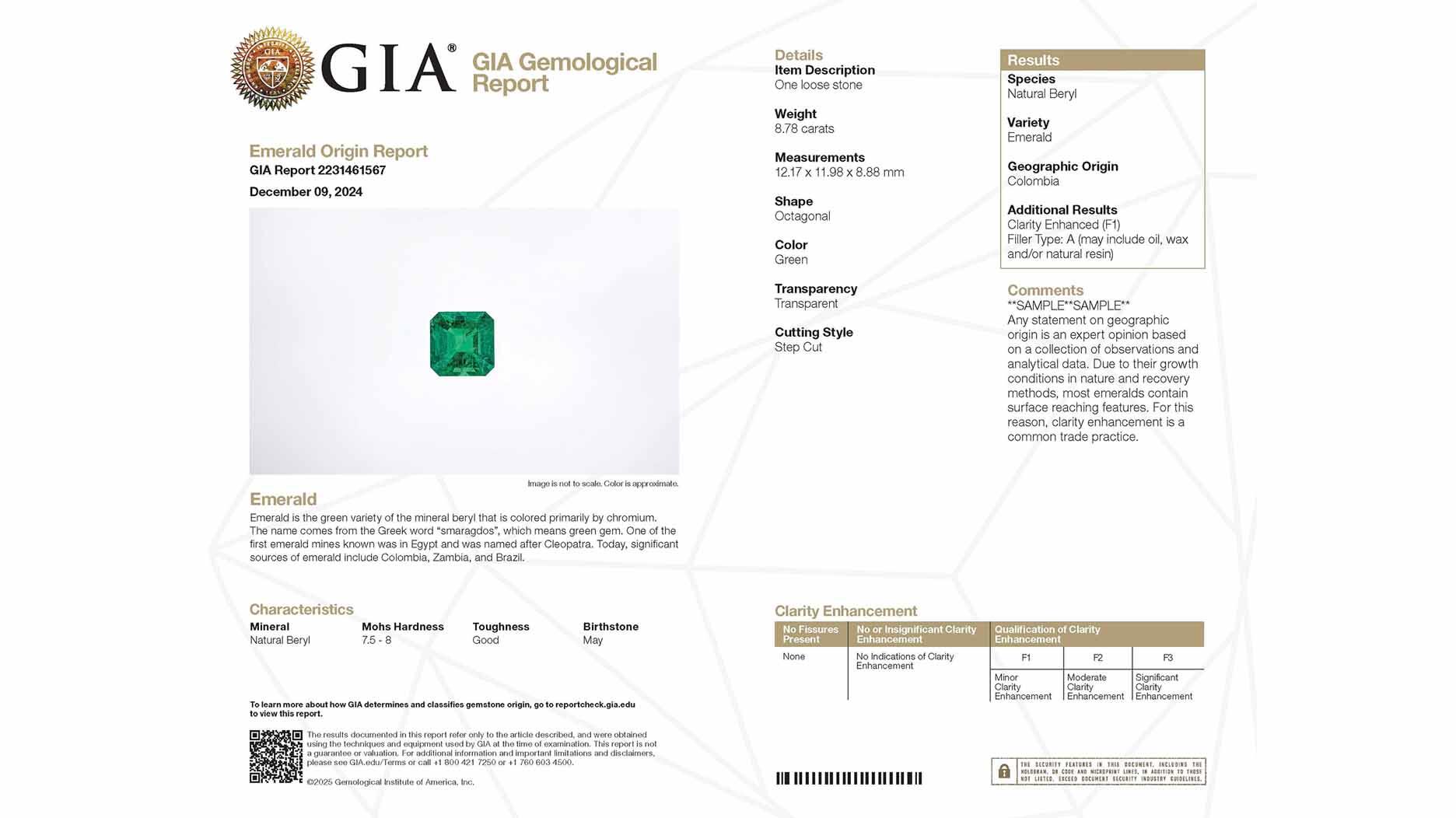10 Questions with GSI President Debbie Azar
Azar shares her thoughts on the future of diamond detection, screening melee today, “bad actors,” and more.

Some love selling them. Some view them as a threat to the natural diamond market and some just flat-out dislike them.
Opinions aside, being able to separate lab-grown from natural diamonds is important to all parties, making the industry’s grading labs even more indispensable.
Gemological Science International (GSI) says it was one of the first gemological laboratories to find undisclosed lab-grown diamonds mixed into natural diamond jewelry.
Recently, the lab’s president, Debbie Azar, connected with National Jeweler to talk more about the latest detection methods, and how the lab is instilling confidence in its clients.
National Jeweler: Tell us about GSI’s role in the screening and detection process.
Debbie Azar: Recognizing an important need for the jewelry industry, we developed the only service of its kind – screening and detection of all types, sizes, qualities, and price points of jewelry for laboratory-grown diamonds and synthetic colored gemstones.
We developed this service with the retailer in mind, knowing how important it is that they meet the needs for transparency and disclosure of the informed, educated jewelry buyer.
GSI developed proprietary screening and detection processes that have a proven track record. Our processes require specialized equipment, a high level of expertise, ability to stay ahead of new developments, and essential business relationships with equipment developers, diamond growers, manufacturers, and other stakeholders.
We have created a system that can reliably screen and detect laboratory-grown diamonds, natural diamonds, and natural and synthetic colored gemstones, loose or in jewelry of any size, shape, or quality. This is an accomplishment we are proud of, and we see it as vital for our industry.
NJ: In the 16 years you’ve been with the lab, how have the business and the industry changed?
DA: The digital era has made information available at the consumers’ fingertips, and social media has made spreading information easier than it ever was.
In this 24/7 news climate, accuracy, transparency, and full disclosures have become critical to maintaining a jeweler’s reputation and improving consumer confidence in our industry.
The educated consumer—combined with more laboratory-grown diamonds on the market, ever-evolving treatments, and increasing requirements for disclosures and transparency—means top-tier gemological laboratories are more needed than ever.
NJ: In 2018, GSI opened an office dedicated to the screening of lab-grown diamonds. Why was it important for the lab to have a separate space for these stones?
DA: It’s more of a dedicated facility as opposed to a separate space. And there are many reasons for this.
Screening and detection started off as an extension of our laboratory and quickly grew into its own unique service. It is important to have a dedicated laboratory facility because of the complexity of the screening and detection process.
Our process requires a team with specific expertise who have specialized knowledge and skill sets in screening and detection. We also use specialized equipment and a workflow specific for laboratory-grown diamond and synthetic [colored] gemstone detection.
Also, we are screening finished jewelry, in addition to loose stones, and jewelry can require different equipment, depending on its size or shape.
All of our laboratories work together - grading, testing, research, education, and special projects teams all work in conjunction with one another globally to ensure that essential knowledge is transferred across the organization, and we continually deliver on our high standards to our customers.
Communication and consistency are key.
NJ: Which instruments does GSI use in the lab-grown diamond office and how are they selected?
DA: We use different screening and detection equipment in conjunction with each other, along with the knowledge and expertise of our scientists, researchers and professionals and have developed a proprietary process that comes from years of experience.
Because of the high volume of goods we process, we work with the screening and detection equipment manufacturers to help build out and test their equipment.
It important to note that it’s not just the equipment, but the process and knowledge of the people who utilize the equipment. We use everything and anything, from [De Beers’] DiamondSure, DiamondView and Synthdetect, [to] Yehuda’s Sherlock Holmes, [to] FTIR, a Raman spectrophotometer with various wavelengths, XRF and others.
We select the best equipment that is available and then work with them directly to make off-market modifications to work with our internal processes.
From the start, we decided not to manufacture our own equipment. This allows us to be completely unbiased when it comes to equipment from different manufacturers and focus on how we can utilize various equipment and technology for screening and detection. Our mutually beneficial relationships with our equipment manufacturers are an important part of being able to accomplish what we do.
NJ: We’ve published quite a few stories about “diamonds” being submitted to grading labs worldwide that turned out to be something else. In terms of attempted fraud, what does GSI see most often?
DA: While there are “bad actors,” it is important to clarify that I do not believe it is typically intentional fraud but, most often, a lack of knowledge when a client submits an undisclosed laboratory-grown diamond, synthetic colored gemstone, or a simulant.
It is most often a result of a flaw in a manufacturer’s internal processes where we see undisclosed laboratory-grown diamonds.
GSI’s philosophy is to not publish any and every time we catch something, but only if we believe it will help educate the industry, or other laboratories.
As an example, we detected some color instability in CVD (chemical vapor deposition) lab-grown diamonds a year or so ago, and we published an article to let the industry know that they should be aware of it.
It was also important to let the industry and the labs know and understand that the right conditions are required when color-grading lab-grown diamonds. At GSI, we recommend that all laboratory-grown CVD diamonds are placed in a full-spectrum light box for at least 30 minutes before color-grading.
Also, we started to detect natural diamond melees in lab-grown diamond jewelry. For consumers who wish to purchase lab-grown diamond jewelry, this is equally important as detecting non-disclosed lab grown stones.
We published an article about this earlier this year, just to let the industry know that they must be just as careful when vetting lab-grown diamond jewelry.
NJ: What is your sense of the number of undisclosed lab-grown diamonds being submitted to grading labs? Is this a major problem for the industry?
DA: Unfortunately, we can’t disclose the exact numbers, but the numbers of undisclosed laboratory-grown diamonds we detect is increasing exponentially, globally. I believe it is a problem that will continue to grow for a few reasons.
One reason is because as the laboratory-grown diamond supply is growing, and some manufacturers are cutting, polishing, and setting natural and laboratory-grown diamonds in the same facilities, it is inevitable that goods will get unintentionally mixed.
Another reason is the complexity and time it takes to screen and detect jewelry.
While some individuals can be trained to operate basic screening equipment, it’s far more difficult and complicated to use the advanced equipment required for detection and it also requires a specific level of expertise and knowledge. So companies that try to do it internally are likely to make mistakes, even with good intentions.
NJ: How does GSI handle the screening of melee?
DA: Every stone is screened and checked by our experts, using much the same process and equipment as larger stones.
Screening melee or smaller diamonds set into jewelry is significantly more complicated. We have a unique expertise and proven track record with our proprietary process for testing jewelry.
This is a proven process that we have developed over the past few years with data we have acquired from the millions of diamonds and jewelry that come through our laboratories.
NJ: It can be devastating to a company’s reputation to mistake a lab-grown diamond for a natural one, even once. How do you instill confidence in the clients you work with?
DA: I believe we instill confidence in our clients by always striving to improve and by setting high goals for ourselves and delivering on them. We don’t make any excuses. We deliver the highest level of service with integrity and stand behind everything we do.
NJ: What do you foresee diamond detection will look like five years from now?
DA: Lab-grown diamond growers continue to evolve and develop more sophisticated growing methods to create laboratory-grown diamonds that more closely resemble natural diamonds.
The diamond pipeline will continue to have a mix of natural and laboratory-grown diamonds. And consumers will continue to have a growing need for transparency, especially as they are now better understanding the differences between natural and laboratory-grown diamonds and gemstones.
Not only do consumers need assurances that what they’re buying is what they were told it is, but retailers need the same assurances about what they are buying and receiving from manufacturers.
There are no days at GSI where we have just “textbook” cases. We make new discoveries every day as we work to protect the industry and retailers.
And there is no “one step” machine or piece of equipment that tells you everything you need to know about your diamonds. We remain committed to high standards and are proud of our proven track record in the industry.
The Latest

The couple pleaded guilty to concealing at least $127 million in cash transactions at its precious metals businesses.

Consumers shared concerns about prices, inflation, tariffs, trade, and politics in the survey’s write-in response section.

In February 2026, the auction house will move its headquarters to the former Steinway Hall, a neoclassical landmark on Billionaires’ Row.

How Jewelers of America’s 20 Under 40 are leading to ensure a brighter future for the jewelry industry.

The new show will take place Jan. 23-25, 2026.


The former BHP Billiton leader and Gemfields chairman is remembered for his influential leadership throughout his 50-year mining career.

The LVMH-owned brand has partnered with the costume design union to revamp its award for 2026.

Roseco’s 704-page catalog showcases new lab-grown diamonds, findings, tools & more—available in print or interactive digital editions.

The luxury titan inked a deal to acquire an initial minority stake in the jewelry manufacturer with a pathway to full ownership by 2032.

The company’s curation of unsigned vintage and estate jewelry debuted at the Bloomingdale’s in Costa Mesa, California.

In the recent multi-shipment seizure, CBP also found counterfeit Audemars Piguet, Moncler, and Chrome Hearts items.

Helzberg’s Chief Retail Officer Mitch Maggart shared details about its tests of a new store concept rooted in an elevated luxury experience.

Jewelers of America execs and National Jeweler editors discuss tariffs, the sky-high gold price, and the engagement that broke the internet.

The luxury goods company said founder Ippolita Rostagno will remain at the brand’s helm.

Laura Burdese, who joined the Italian luxury brand in 2022, will take on the role in July.

The National Jeweler editors revisit the most noteworthy industry happenings and design trends from 2025.

Need a gift for the cat lover who has everything? Look no further than our latest Piece of the Week.

It purchased the “Grosse Pièce,” an ultra-complicated Audemars Piguet pocket watch from the ‘20s, for a record-breaking price at Sotheby’s.

The lab-grown diamond grower now offers custom engagement and fashion jewelry through its Kira Custom Lab Jewelry service.

Chandler got his start at Michelson Jewelers and has served as DCA president and CEO since 2001. He will retire at the end of the month.

The boutique is slated to open this week inside Terminal 8, offering pre-owned Rolex watches and more to international travelers.

Sponsored by Digital Monitoring Products

The special-edition egg pendant ingested in a New Zealand jewelry store was recovered after a six-day wait.

Associate Editor Natalie Francisco plays favorites with Piece of the Week, selecting a standout piece of jewelry from each month of 2025.

The “Love and Desire” campaign is inspired by the magic that follows when one’s heart leads the way, said the brand.

Berta de Pablos-Barbier will replace Alexander Lacik at the start of January, two months earlier than expected.

Sotheby’s held its first two jewelry sales at the Breuer building last week, and they totaled nearly $44 million.



























